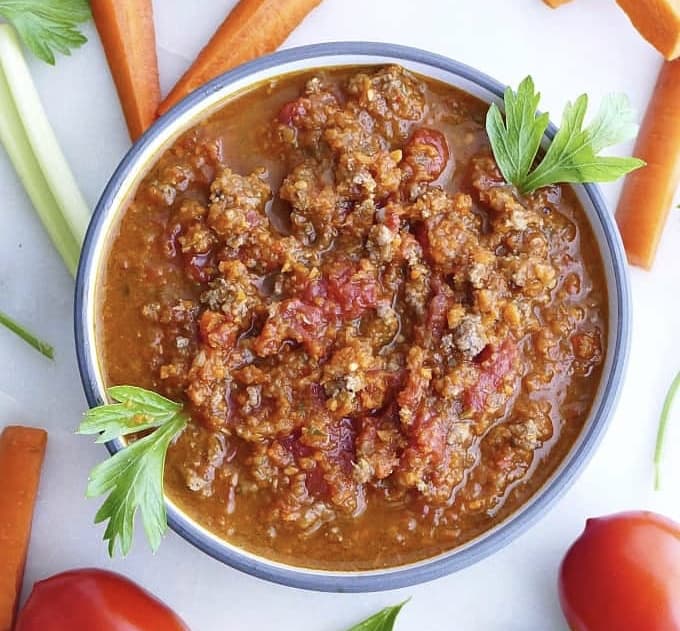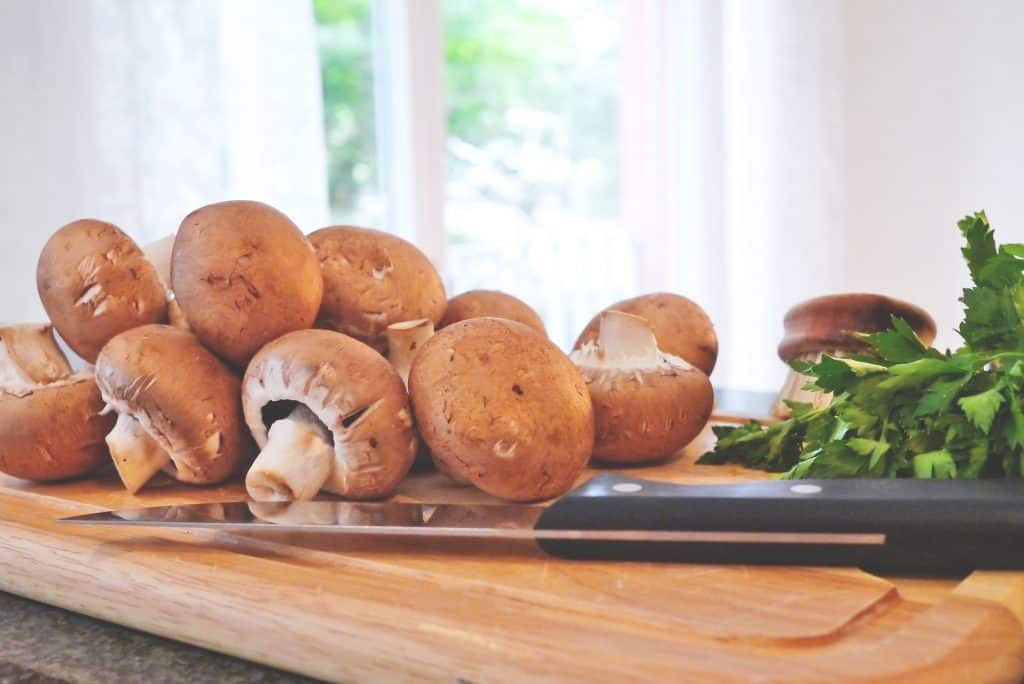If you have a family to feed every day, and you’re on a tight budget, you’re probably wondering how to stretch the meat you have on hand to make satisfying meals. Though you may not be able to purchase all the meat you’d like, or readily find your favorite cuts, it’s possible to extend meat with these easy, delicious recipes from my foodie friends, and simple tips for how to make meat go further.

Mexican Chicken & Rice Soup from The Nutrition Adventure
How to Make Meat go Further with Beans
Beans (legumes) bulk up meat dishes. They are a relatively low-cost alternative to some of the meat in your favorite recipes and a welcome, healthy addition even when meat is readily available.
You probably won’t even notice you’re eating less meat with beans in the mix. Legumes, such as black beans, garbanzos, and lentils, add interest and texture to meat-based dishes, and they provide eating satisfaction, too. Beans are rich in a variety of nutrients, and their protein and fiber help you feel fuller for longer. As plants, they contain phytonutrients, which help protect cells from damage.
Easy Beef and Bean Chili uses just 8 ounces of ground beef to make 6 servings!
You don’t have to prepare beans from dried. It’s perfectly fine to use canned beans and lentils for the sake of convenience, but it’s less expensive to cook the dried versions. Here are some delicious recipes that pair beans with meat or poultry:
Spanish Brown Rice and Beans from Juggling with Julia
One Pot Taco Soup from The Cheesy RD

Chicken Dhansak from Desilicious RD
Spiced Chicken Stuffed Zucchini with Brown Rice and Lentils from Tasty Balance Nutrition
How to Make Meat Go Further with Mushrooms
Though mushrooms don’t supply as much protein and fiber as beans, they can be an excellent or good source of certain minerals, such selenium and copper, and vitamins, including B vitamins and vitamin D, a nutrient that is often in short supply in our diets and may play a role in supporting the immune system. Like beans, mushrooms supply phytonutrients, and are a lower-cost filler that adds interest to meat dishes while contributing zero cholesterol or saturated fat.
Mushrooms that have been exposed to ultraviolet light are richest in vitamin D. It’s the same for humans: strong summer sunlight, in the form of ultraviolet rays, prompts vitamin D production in the body. However, not all mushrooms are high in vitamin D, so check package labels to make sure.
Mushrooms have a firm, meat-like texture that pairs particularly well with ground meat. A beef and mushroom blend lends itself to burger, taco, meatloaf, lasagna, pasta sauce, and meatball recipes.
I typically use 1 cup cooked, diced mushrooms per pound of ground meat (although sometimes I add even more mushrooms!) So, if you’re working with 8 ounces of lean ground beef, add 1/2 cup of cooked mushrooms. For 1/2 cup cooked mushrooms, start with 4 ounces raw.
Try these delicious, juicy Beef and Mushroom Burgers!
It’s easy enough to buy fresh mushrooms, but you are probably limiting trips to the store right now. In that case, considered dried mushrooms, which can be reconstituted and used like fresh on a moment’s notice.
In addition to ground beef, mushrooms go well with chicken, pork, and shrimp, too! Here are some easy, delicious recipes that pair mushrooms with high-protein foods:
Stuffed Cabbage Rolls from Snacking in Sneakers

Creamy Mushroom and Shrimp Pasta from Fad Free Nutrition
Ground Beef and Mushroom Lettuce-Wrap Tacos from Craving Something Healthy
Blended Al Pastor Tacos with Pineapple Jalapeño Slaw from the Mushroom Council
Other vegetables help you go further with meat, too. Here’s an example of how to “beef up” pasta sauce:

Hidden Vegetable Pasta Sauce from It’s a Veg World After All
How to Make Meat Go Further with Cottage Cheese
Cottage cheese may not come to mind as a meat extender, but it’s rich in protein and offers calcium, too. In fact, one cup of low-fat cottage cheese has more protein than the same amount of plain, fat-free Greek yogurt. (However, the cottage cheese has about 25% less calcium.)
You may be put off by the curds in cottage cheese. I have a solution for that!
Place as much cottage cheese as you need at the time in a small food processor or blender and blend for about 45 seconds to 1 minute to produce creamy cottage cheese.
I use creamy cottage cheese in meatballs or burgers made with lean ground beef or 100% ground turkey breast. Cottage cheese extends the ground meat, and it also produces lighter and juicier meatballs and burgers.
How to Make Meals With Less Meat
Almost Lasagna is one of my favorite recipes that pairs meat with cottage cheese. If you don’t want to bother with a recipe, simply stir creamy cottage cheese into warm marinara sauce or mix cottage cheese with warm pesto sauce and serve over cooked pasta. If you have some cooked chicken, beef, or other meat, add that, too.
Almost Lasagna
Ingredients
- 16 ounces long fusilli pasta, linguine or other pasta Or any type of pasta you have, including whole wheat.
- 8 ounces 95% lean ground beef or 100% ground turkey breast
- 2 tablespoons olive oil
- 1 medium carrot, diced
- 1 medium onion, diced
- 2 cloves garlic, diced
- fresh ground pepper, to taste
- 1 cup low-sodium beef broth or stock
- 1 28-ounce can crushed no salt-added tomatoes, not drained Diced tomatoes work well, too.
- 3 fresh basil leaves, torn into small pieces
- 1/3 cup fresh flat-leaf parsley, chopped
- 2 tablespoons butter
- 1 cup plain lowfat cottage cheese
Instructions
- Bring a large pot of water to a boil, salt it, add the pasta and cook until al dente. Drain and keep warm.
- Meanwhile, heat a large skillet over medium heat. Add the beef, breaking it into large pieces and continuing to break into small bits. Cook until lightly browned, about 4 to 5 minutes. Remove the skillet from the heat and transfer meat to a medium bowl, and set aside.
- Return the skillet to the burner, add the olive oil, and heat over medium heat. Add the carrot, onion, and garlic and cook until the vegetables are softened, about 5 minutes. Season with fresh ground black pepper.
- Add the meat back to the pan. Stir in the beef broth, tomatoes and their juices, and basil, and simmer on low heat for 10 minutes.
- In a small bowl, mix the cottage cheese and parsley.
- Toss the pasta with the butter, transfer to the skillet and combine with the meat sauce. To serve, place equal amounts of the cottage cheese/parsley mixture in shallow soup bowls, and top with the pasta mixture. Garnish with grated Parmesan cheese, if desired.
Notes







Great tips in this post! Mushrooms are my go-to for extending meat but I never thought about using cottage cheese – that’s brilliant. I need to try it!
I use cottage cheese a lot in cooking instead of ricotta because I always waste ricotta, but not the cottage cheese.
Pingback: How to Make Do in the Kitchen with Ingredient Substitutions | Better Is the New Perfect